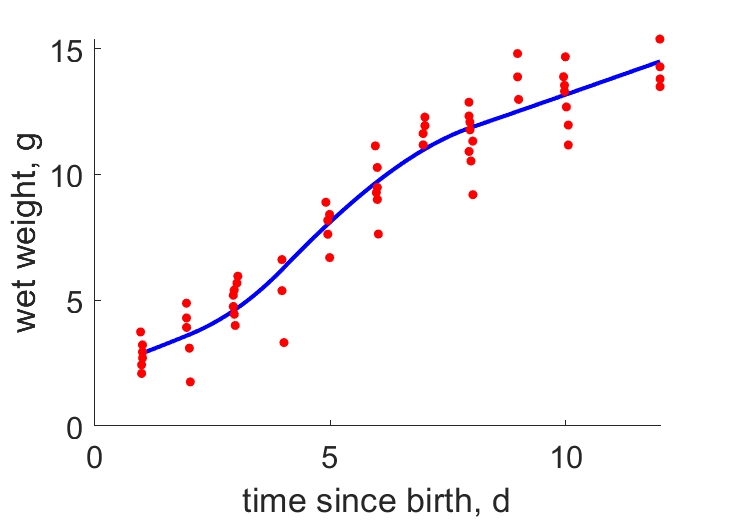Predictions & Data for this entry
| Model: std | climate: A, Cfb | migrate: | phylum: |
| COMPLETE = 2.7 | ecozone: TN | food: biCi | class: |
| MRE = 0.042 | habitat: 0iTf, 0iTh | gender: Dg | order: |
| SMSE = 0.005 | embryo: Tnpfm | reprod: O | family: |
Zero-variate data
| Data | Observed | Predicted | (RE) | Unit | Description | Reference |
|---|---|---|---|---|---|---|
| ab | 17 | 17.21 | (0.01233) | d | age at birth | NiklAret2008 |
| tx | 13.3 | 13.24 | (0.004246) | d | time since birth at fledging | NiklAret2008 |
| tp | 39.9 | 39.47 | (0.01081) | d | time since birth at puberty | guess |
| tR | 365 | 365 | ( 0) | d | time since birth at 1st brood | guess |
| am | 1825 | 1829 | (0.002284) | d | life span | guess |
| Ww0 | 2.78 | 3.263 | (0.1738) | g | initial wet weight | NiklAret2008 |
| Wwb | 2.3 | 2.193 | (0.04641) | g | wet weight at birth | NiklAret2008 |
| Wwi | 16.48 | 16.73 | (0.01533) | g | ultimate wet weight for females | NiklAret2008 |
| Ri | 0.005479 | 0.005426 | (0.009741) | #/d | maximum reprod rate | NiklAret2008 |
Uni- and bivariate data
| Data | Figure | Independent variable | Dependent variable | (RE) | Reference |
|---|---|---|---|---|---|
| tW |  | time since birth | wet weight | (0.09599) | NiklAret2008 |
Pseudo-data at Tref = 20°C
| Data | Generalised animal | Grallaricula ferrugineipectus | Unit | Description |
|---|---|---|---|---|
| v | 0.02 | 0.02952 | cm/d | energy conductance |
| p_M | 18 | 657.3 | J/d.cm^3 | vol-spec som maint |
| k_J | 0.002 | 0.02723 | 1/d | maturity maint rate coefficient |
| k | 0.3 | 0.303 | - | maintenance ratio |
| kap | 0.8 | 0.9691 | - | allocation fraction to soma |
| kap_G | 0.8 | 0.8009 | - | growth efficiency |
| kap_R | 0.95 | 0.95 | - | reproduction efficiency |
Discussion
- Body temperature is guessed
- Males are supposed not to differ from females
- mod_1: Pseudo-data point k is used, rather than k_J; Data set tp and parameter t_R are added, the latter replacing clutch interval t_N. Postnatal T is based on PrinPres1991, see get_T_Aves. See further the revision page, theme puberty
Bibliography